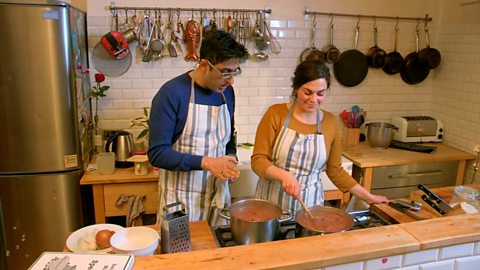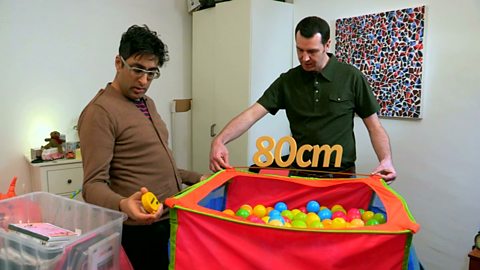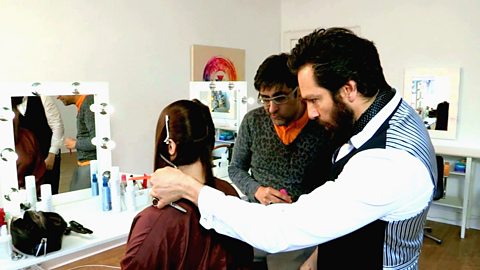Area. Who needs area? Well, we all need area. Area defines the size of the surface. And we all live on surfaces. Unless you're hovering. Are you hovering? No. Are you hoovering? Well, clearly not, judging by the state of your room. How long has that apple been there? If you are hoovering, though, you're hoovering a carpet. A surface. A surface that requires material. How much material? Area.
This bathroom is minging. Don't worry, it's not mine! Like I would use a bathroom like this. No, it's my mate's and I've decided to give it a secret makeover. I've arranged for her to be away for the day and I'm going to transform this space and hopefully make her cry as well, because, well, all the best makeover shows do, don't they? I've got tiles, I've got paint. What I don't have is any idea if I've got too much or not enough of that stuff. I don't have much time but thankfully help is at hand.
This is Steven. How are you doing, Steven?
Hi there. How are you?
Now you're a tiler by trade, aren't you?
Yes, I am.
So is maths something you use every day?
Yes, we use it every day. We use it for pricing jobs and measuring jobs.
So is area your specialist area?
Yes, we need to work out how many tiles we need.
OK. Good, so you can help me to work out if I've got enough of THIS to cover all of this.
Yes, I can do.
Cool. Let's do some magic!
OK, Steven, where do we start?
We need to work out where you want to tile.
OK, well, here's my vision. OK. I'm thinking tiles from the bath up to the rail.
How far along do you want to go?
Well, again, part of my vision is that I want to contain the aquatic space so I'm thinking just actually to the edge of the bath.
Then we'll need to measure the length by the height.
OK. Well, do you want to do the length and I'll do the height?
Fine.
So the length is 170 centimetres and the height is 96 centimetres. Right, good, so that's us worked out the area that needs to be tiled so do we have enough tiles?
Yes, I think so but we'll need to measure the area of one tile to see if I've got enough.
OK, right. Well, I'll hold the tile if you can do the measuring.
It's 15 centimetres by 15 centimetres.
OK. So the area of one tile is length times breadth, which is 15 centimetres by 15 centimetres which is… 225 square centimetres.
(That's very good…)
So to work out how many tiles we need, we divide that area by the area of that.
That's correct, yes.
Right, so we need 72.5 tiles. What does that mean?
What we'll need to do now is we need to add 10% for waste or breakages which is about 80 tiles.
OK, so that's something that you normally do?
Every time.
OK, well, that's good news because 80… we have 80, so we can get cracking.
Yes.
OK, good - let's get started then!
Right, these are all meant to be white.
Yep.
Er, well, this wasn't part of the vision. Right, do you know what, though? Let's get creative. Right, OK. Tell me what you think of this, OK? So we still have the white in the middle…
Yes.
But we use these tiles to sort of create a border round there. Do you think that might work?
Yes, just tile the perimeter in yellow then?
Aha.
Yes.
But do we have enough of these tiles to do that?
We should do, yes.
Steven's quick maths confirms I've got enough tiles for my border. Result! Wish I'd had his maths skills when I bought the paint. Turns out I've got enough for the bathroom, the kitchen, and a small car.
Oooh! My pal's going to love this!
That's me finished.
Well, I've just heard my friend is on her way back now and I genuinely, genuinely think we're going to see tears. Oh, yeah.
FRIEND SCREAMS
Video summary
Sanjeev Kohli sets out to refurbish a friend’s bathroom.
A tiler shows how they need to calculate the area of the wall to be tiled, and then divide this by the area of each tile to work out how many tiles need to be bought.
The tiler then adds 10% for wastage and breakage, just to be sure.
This clip is from the BBC series Who Needs Maths?
Teacher Notes
This could be used as a functional maths example during a topic on areas of quadrilaterals.
Pupils can fill in their own bathroom designs from a template, and work out the area they are going to tile, and the number of tiles that they will need.
For extension, they could have different tile designs costing different amounts.
This clip is relevant for teaching maths at Key Stage 3 and Third/Fourth Level in Scotland.
Ratios and fractions. video
Making a recipe stretch to serve more people needs the help of ratios and fractions.

Volume. video
Will all the boxes fit into the van? Calculating their volume reveals the answer.

Angles. video
Hairdressers use angles to create a pleasing shape in a haircut.
